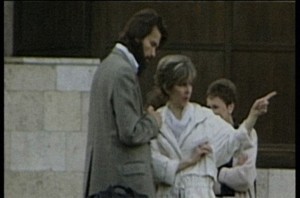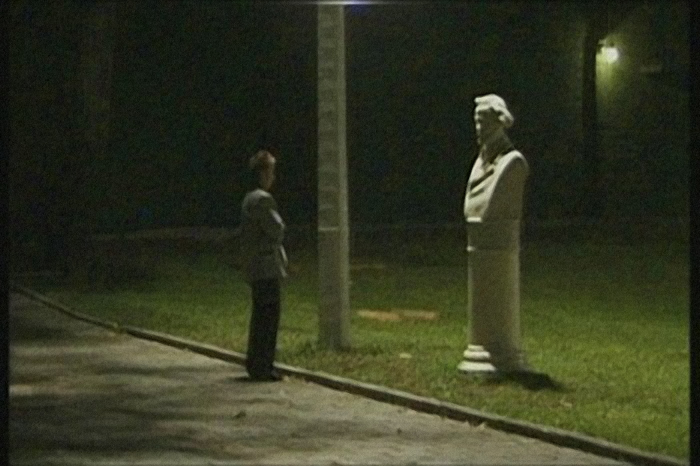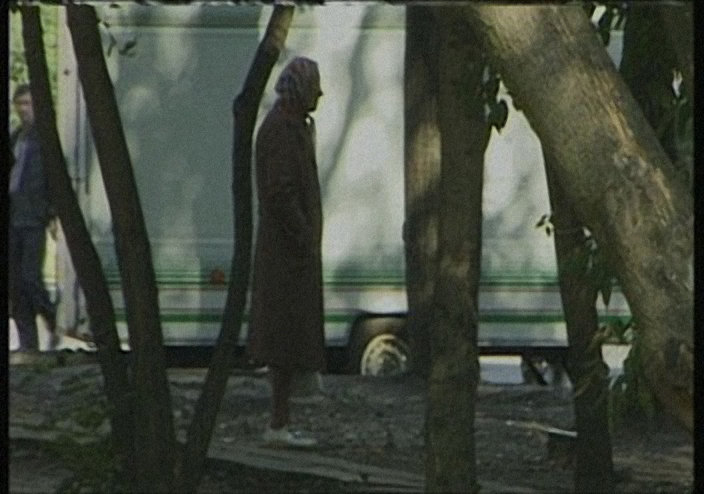A rhythmical shortfilm based on public life in Moscow, inspired on the short stories of Daniil Charms. The main character, never visible as a voyeur, observes public life in this intriguing, chaotic city. The film had its première at the Kunstenfestival, Brussels, and was shown at Viewpoint, Videofestival, Gent amongst other European festivals.
It won the ‘prix du jury’ in the ‘Entrainements # 4’ festival in Paris, 2003.


Moscow, August 1999. Choreographer Hans Van den Broeck, Benoît Vivien – an acrobat, magician, musician and actor in La Sortie (their last production) – and Martine Van Hecke – a translator who had lived in Russia for many years – are there to work on a film project. In 1995, when Everyman was on tour in Moscow, Hans met Georgii Michailovski, an actor and fabulous storyteller. Four years later, Hans, Benoît and Martine joined Georgii in Moscow with their digital video camera, a joint project, to delve into the everyday life of the city and to pay tribute to its strange beauty. Summer in Moscow is a time when life and living move outdoors. It is pleasantly warm and free from the harshness of winter, Muscovites pour into its public spaces.
A few weeks later it would have been impossible to make the film. Shaken by a wave of violence that the Kremlin attributed to ‘Chechen terrorists’, Moscow was under a state of siege, controlled by the army and police. But during this quiet summer of 1999, without having permission to film, Hans and his friends discreetly set down their camera in parks, on suburban streets and busy city centre roads. The team members took it in turn so as not to attract the attention of the police, who would have immediately confiscated their equipment. A jovial bunch, the Muscovites called out to them and asked them what they were doing or, impassively going about their business, ignored them.
“We came with the idea of trying out little scenes in order to create some kind of interaction with passers-by in the street. But we immediately realised that this was a ridiculous way of going about things and totally out of place. The best thing we could do was to let the city come to us, make ourselves available to capture what it had to offer without resorting to artifice. It was the hardest approach to take because we had to be incredibly patient, resigning ourselves to wanting to control nothing, snatching at random things, collecting bit by bit the irregular pieces of a jigsaw whose picture would only become apparent later when the pieces had been carefully assembled. In our luggage we had brought a few short stories by Daniil Charms, a surrealist writer in Moscow in the 1920s. The only intuition we had was that even today the tone of his absurd short stories still expressed the subterranean mentality of this enormous, modest and exuberant, tragic and comic, decrepit and courageous city, still expressed its heady poetry.”
The film is called Our circumscribed days, a way of approaching Moscow from its circumference, a kind of portrait only just above the surface that borrows the roundabout fleeting moments, surreptitiously penetrating the intimacy of everyday life. Guidebooks say that historically the city of Moscow has been built according to a radial and circular urban layout. The inner ring is made up of the walls of the Kremlin, the next by the ring of boulevards known as ‘Sadovoïe’, the third by the circular motorway abutted by the streets and radial avenues that leave the Kremlin. In Hans Van den Broeck’s film there is no Kremlin, none of the usual hackneyed images, no exoticism. The only words to be heard, those of Charms, had appealed to Hans because his short stories develop in loops: a downfall returning to its beginning, unless the beginning is already an end…
His choreographic intuition immediately removes any sordid realism and concentrates on the people, their energies, the spontaneous movement as they go about their lives. “It isn’t a film containing dance”, he makes clear, “but a film containing rhythm. ‘Our circumscribed days’ are also the words of a very beautiful old Russian folk song by Alexander Vertinsky. It evokes the warmth of friends coming together again. We put it on the soundtrack when we finished editing it, in a sequence containing a moving and zany celebration. With Dirk D’Hooghe, who was a great help during editing, we looked at the rhythm of the meeting.” They are rhythms that hang around in real time as the seconds pass, inflected with waiting and punctuated by chance events; rhythms sometimes amplified by amusing fast-forwards à la Tati or the suffocating slow motion of destitution; rhythms gathered up, drawn out, syncopated or suddenly suspended… brief accounts of things that happened during those summer days of 1999 in Moscow.

The action takes place under a big 1930s cupola in a green park, its open spaces bathed in sunshine, the air replete with the tunes of old tangos, quick steps and cha-cha-chas. Public ballroom dancing lessons are being held, the dancers practise enthusiastically. The couples twirl round, a smile on their lips, carrying their heads elegantly, performing rapid and precise convolutions. “It was fun to watch and very touching. Dancing together spontaneously in public places doesn’t happen here any more. It will probably disappear over there at some point, but it is one of the palpable signs that still exist of what had, for such a long time, been a collectivist society.”
Further on, there are railings that bizarrely separate imitators of the more ‘trendy’ techno music from the curious onlookers observing them.
A young man driving an old Lada keeps turning in an empty square, practising driving between a water bottle and an oil can. The learner driver ends up driving over the can. The dismembered leg of a dummy lies right next to it.
His small case lying on a small stone bench, a man in a suit stands reading the newspaper on a path in a park. Suddenly he folds it up, tidies it away and puts his glasses on to leave.
In the street another man, wearing a blue suit, sways to and from, his back against the wall. His brain befuddled, he struggles to remain standing before, exhausted, he slips down to the ground in a heap, curled up with his back to passers-by. “Of course your first impression is that he’s completely drunk on vodka! But his solitary swaying turned into real choreography for me, at once delicate and touching.”
“Georgii had an extraordinary eye for capturing the ‘absurd’ dimension of everyday life, beyond the trivial. But we had great discussions on the notion of the ‘absurd’. For him, a Muscovite through and through, the ‘absurd’ is the norm; it can be found in the roundabout means needed to define or confront reality. For me it was about the occasionally strange nature of behaviour. But maybe it wasn’t the attitudes that were incongruous, maybe it was reality itself…”

ANALYSIS – COMPARATIVE STUDY by AGNESE KUŠNERE
“Walking in Circles – Post-Soviet transit spaces from the cinematic viewpoint of Chantal Akerman and Hans Van den Broeck” PDF